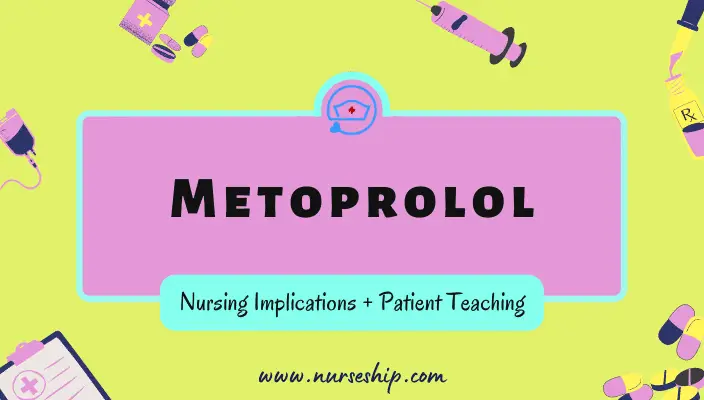Introduction
In this article, you’ll learn about Metformin’s nursing implications and patient teachings. Also, its dosage, indication, side effects.
Generic Name: Metformin
Brand Names: Fortamet, Gen-Metformin (CAN), Glucophage, Glucophage XR, Glumetza, Glycon (CAN), Riomet
Metformin Class and Category
Pharmacologic class: Biguanide antihyperglycemic
Therapeutic class: Oral anti-diabetic agent
Pregnancy category: B
Metformin Dosage
Adults: PO: Initially: 500 mg 1-3 times per day with or shortly after meals. Then gradually increase the dosage as needed. Maximum dose: 2550 mg/day.
Adults: PO (ER): 500 mg OD with the evening meal. Maximum dose: 2,000 mg/day.
Metformin Pharmacokinetics and Pharmacodynamics
| Route | Onset | Peak | Duration |
| PO | Unknown | Up to 2 wks | 2 wks after discontinuation |
Absorption: Slow and incomplete absorption.
Distribution: Protein binding is 0%.
Metabolism: not metabolized.
Half-life: 6 – 17 hours
Excretion: primarily excreted in the urine unchanged. Can be removed by hemodialysis.
Metformin Mechanism of Action
Metformin inhibits hepatic glucose production. It also reduces glucose absorption in the intestine while increasing insulin sensitivity.
Furthermore, metformin has a minor effect on total cholesterol and triglyceride levels in the blood.
Therapeutic effects of metformin:
- Increases insulin sensitivity
- Controls blood glucose levels
- Helps to reduce weight.
- Helps to reduce total cholesterol and triglyceride levels
What are the indications of metformin?
Metformin indications include:
- Diabetes Mellitus (DM) Type 2
Off-label uses include:
- Polycystic ovarian syndrome
- Gestational diabetes
- Pre-diabetes
What are the contraindications of metformin?
The contraindications of metformin are:
- Hypersensitivity to metformin and its components.
- Diabetic ketoacidosis
- Metabolic acidosis
- Radiographic contrast administration
- Renal failure
Caution: pregnancy, lactation, thyroid disease, HF, diabetes mellitus type 1, cardiopulmonary insufficiency, alcoholism, hepatic or renal disease, alcoholism, acidemia, acute MI, cardiogenic shock, lactic acidosis.
Metformin Interactions
Following drugs may increase the effect of metformin which can result in hypoglycemia.
- ACE inhibitors
- ARBs
- Calcium channel blockers
- Beta-blockers
- Procainamide
- Quinidine
- Digoxin
- Furosemide
- Cimetidine
- Ranitidine
- Azole antifungals
- Trimethoprim
- Vancomycin
- Quinine
- Alcohol
Following drugs with metformin may lead to lactic acidosis or acute kidney failure.
- Iodinated contrast dyes
- Nicotine
- Morphine
- Triamterene
- Thiazide diuretics
Lab interactions
- May alter LFTs
- May decrease vitamin B12
Herbal/food interactions
Following herbs/foods can lead to hypoglycemia when taken with metformin.
- Green tea
- Chromium
- Coenzyme Q10
- Garlic
- Horse chestnut
Glucosamine can lead to hyperglycemia when taken with metformin.
What are metformin side effects?
Metformin side effects / adverse reactions include:
- Dizziness
- Fatigue
- Headache
- Agitation
- Bitter or metallic taste in the mouth
- Anorexia
- Nausea/ vomiting
- Diarrhea/ constipation
- Weight loss
- Malabsorption of amino acids, vitamin B12, and folic acid
Life-threatening adverse effects: Lactic acidosis
| Black Box Warning! |
| Metformin can cause Lactic Acidosis. |
| Alcohol consumption increases risk of lactic acidosis. |
| Immediately stop metformin in case of metabolic acidosis or ketoacidosis. |
Metformin Nursing Implications [Nursing Considerations]
Metformin nursing implications are divided into nursing assessment, interventions, and evaluation.
Metforminnursing assessment
- Obtain comprehensive medical history.
- Assess for signs of hypoglycemia (such as (excessive sweating, weakness, dizziness, anxiety, tremors, hunger) and hyperglycemia (such as fruity-smelling breath, nausea/vomiting, shortness of breath, dry mouth, weakness, brain fog, confusion).
- Obtain baseline CBC, LFTs, RFTs, HbA1c, folic acid, vitamin B12.
Metformin nursing interventions/ actions
- Monitor patient for lactic acidosis symptoms, which can be mild and nonspecific, such as abdominal pain, increased somnolence, malaise, myalgias, and respiratory distress.
- Patient may need immediate hemodialysis to remove accumulated metformin and to correct acidosis.
- Initiation of metformin therapy is not recommended in patients with estimated glomerular filtration rate (eGFR) between 45 and 60 ml/min.
- Metformin is not recommended for patient with hepatic and/or renal failure.
- Monitor blood glucose level to determine therapeutic response.
- Withhold metformin when patient in on NPO for surgical procedure, resume when patient starts orally.
- Withhold metformin 48 hours before and after iodinated contrast studies.
Evaluation
Evaluate the effectiveness of metformin.
- For decreased diabetic symptoms such as polyuria, nocturia, polydipsia, polyphagia.
- For desired therapeutic response such as normal fasting and post prandial blood glucose and HbA1c levels.
- For adherence of treatment regimen.
Pregnancy/breastfeeding considerations for metformin
- Metformin crosses the placental barrier. However, it is not known whether it causes fetal harm. Use only under the direction of physician during pregnancy.
- Metformin is excreted in the breastmilk. Use only under the direction of physician during lactation.
What is the patient teaching for metformin?
- Instruct to take metformin with food or shortly after food and not to chew, crush, or break extended release tablets.
- Tell the importance of adhering treatment regimen and taking medication as prescribe.
- Emphasize the importance of following diabetic diet, regular exercise and foot care.
- Teach the patient/family about the signs and symptoms of lactic acidosis (such as hyperventilation, fatigue, malaise, chills, myalgia, somnolence). Then, instruct to seek immediate medical attention and stop taking metformin.
- Educate the patient regarding increased risk of lactic acidosis with alcohol consumption. Encourage patient to avoid alcohol.
- Teach the patient/family how to monitor blood glucose at home with glucometer, and instruct to monitor blood glucose regularly.
- Teach the patient/family about the signs and symptoms of hyperglycemia and hypoglycemia; and advice what to do in those situations.
- Instruct the patient to avoid OTC drugs without physician’s direction.
- Teach the patient/family about the adverse effects of metformin and to report it to prescriber.
- Advice the patient to carry identification card stating the disease and treatment.
- Inform women of reproductive age that metformin may cause anovulatory females to ovulate. Hence, use an effective contraception if pregnancy is not desired.
Conclusion
You learned about metformin nursing implications and patient teaching in this article. In addition, you’ve learned about metformin’s mechanism of action, pharmacokinetics, dosage, indications, contraindications, and side effects.
Recommended Readings & Reference
FDA Glucophage (Metformin Hydrochloride) Information
Kee, J., Hayes, E., & McCuistion, L. (2015). PHARMACOLOGY A Patient-Centered Nursing Process Approach (8th ed.). Elsevier Inc/Saunders.
Kizior, R., & Hodgson, K. (2021). SAUNDERS NURSING DRUG HANDBOOK 2021. Elsevier Inc.
Jones & Bartlett Learning. (2021). Nurse’s Drug Handbook (20th ed.). Jones & Bartlett Learning, LLC.
Skidmore-Roth, L. (2021). MOSBY’S 2021 NURSING DRUG REFERENCE (34th ed.). Elsevier Inc.




